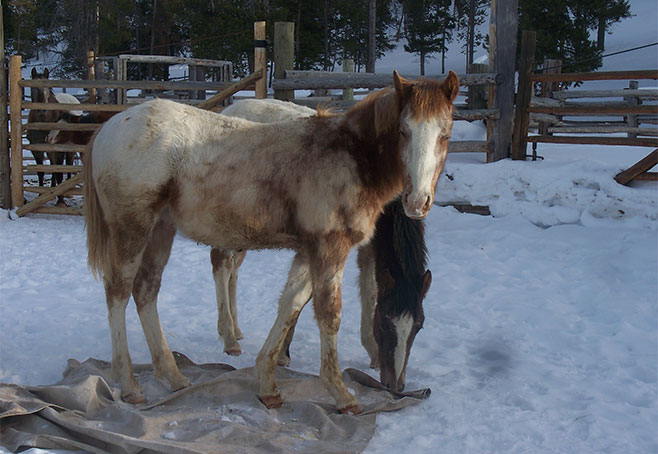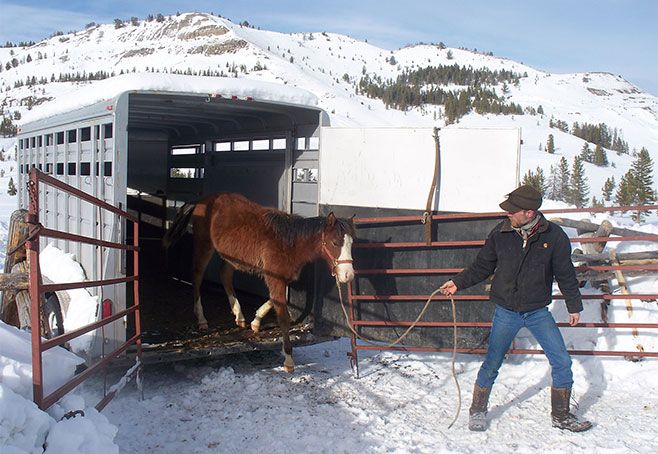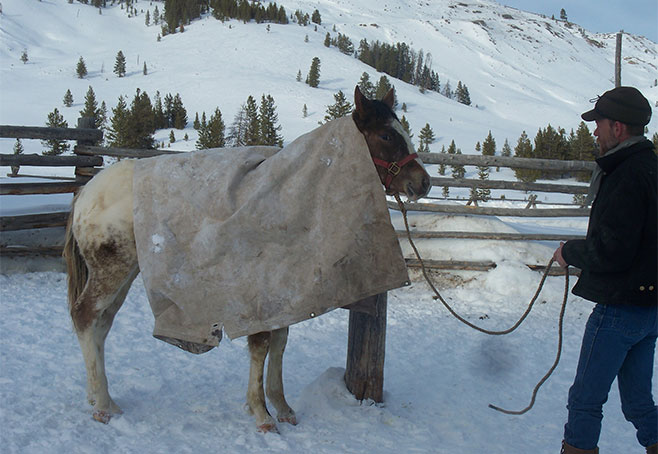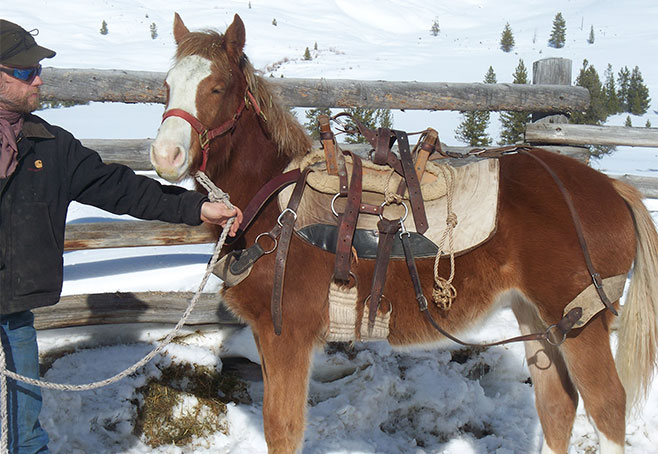Following is the afternoon portion of “Day 2” in our “Day in the Life…” Series. In the first weeks of being brought to the ranch from winter pasture, the foals are getting used to being without Mom, learning how to be caught, haltered, led, touched, pick up their feet and to give at the poll. After these tasks have become familiar, we start adding in more difficult or complicated components.
A “manty” tarp is one of the most-used items when working with our foals. It can be useful for a variety of lesson. This includes as a ground obstacle. Once a foal will allow itself to be caught easily and led around the pen, it must learn to step over, around and on obstacles it may encounter. So, the manty is laid on the ground in a small folded square and each foal is encourage to step on the tarp. We try to discourage them avoiding the tarp, and teach them to step directly on it so they learn that white waving things are not necessarily to be feared. As they grow used to it, the tarp is unfolded until they finally have to step on it with all 4 feet in order to cross it.
Additionally, the tarp is used to “sack” the foals out. It is important to try and teach the young horses not to spook at things that may flap around them or touch them. So, the tarp is flapped around their bodies, slid over and under their back & bellies, pulled up their necks and off their hindquarters and finally over their heads. The more it’s done, the more they grow used to such things.
While most are picking their feet up readily by this point, it is important that they will stand with their foot held for several minutes. So, again, over a period of weeks, their feet are held and cleaned for longer each day. Eventually, Jeff will even trim their feet for the first time and also bangs on each hoof with a light hammer, to prepare them for the novelty of being shod, which will not happen for several years yet.
Hobbling can be one of the most exciting lessons for a young horse. It must be done carefully to avoid injury of the foal OR the trainer. Many will fight and throw themselves until they learn that it won’t hurt them and the easiest thing is to just stand. In our case, the babies were so well gentled and trusting, that the hobbling was quite uneventful. Most just stood and even when encouraged to walk, would only take 1 or 2 tiny steps or none at all.
Later lessons include preparation for saddling and bridling. The sacking out helps them get used to blankets, but to foals, every new item has new potential for fear. So, for some, it takes some time to get them used to the new fuzzy blanket that goes under the saddle. Once they have overcome that, we use a small pack saddle to sit on their back and eventually gently pull the cinch up and work towards getting them used to something tight around their girth. Finally, the rigging is gradually lowered into place and fastened. This all may take days or even weeks to progress to this point. However, once they are comfortable with all the blankets, straps, buckles and ropes hanging on them, they will be much easier to break to riding saddle. For some, we even push on their backs a little or hang light bags of items on the pack saddle, to prepare them for weight on their back.
The last lesson is loading in a horse trailer. While all have been hauled in trailers 2-3 times already, they’ve always been loaded loose, with Mom to help! So, being led into an empty trailer is something new and can be very scary. When we have more reticent babies, though, we often leave the trailer in the pen and feed some hay inside where they can learn that the trailer won’t hurt them. Then, they again are gradually introduced into being led into the trailer, tied for brief periods, and led out. Fortunately, again, these youngsters have learned to trust Jeff and are willing step right into the trailer.
Finally, after six long weeks, the mothers milk will be dried up, and the foals weaned and they can be taken back to winter pasture, along with Uncle Eagle, where they are reunited with Mom and the rest of the herd. They have learned LOTS of new things, and while they will not retain every things they’ve learned, they WILL remember that they were not hurt and that new things can be interesting. It will make the next set of lessons (to occur this summer) that much easier – for both foal and trainer!
I’ve attached several pictures from this portion of the lessons, and there are also several video’s which may be viewed on our YouTube channel at 9QuarterCircleRanch.










